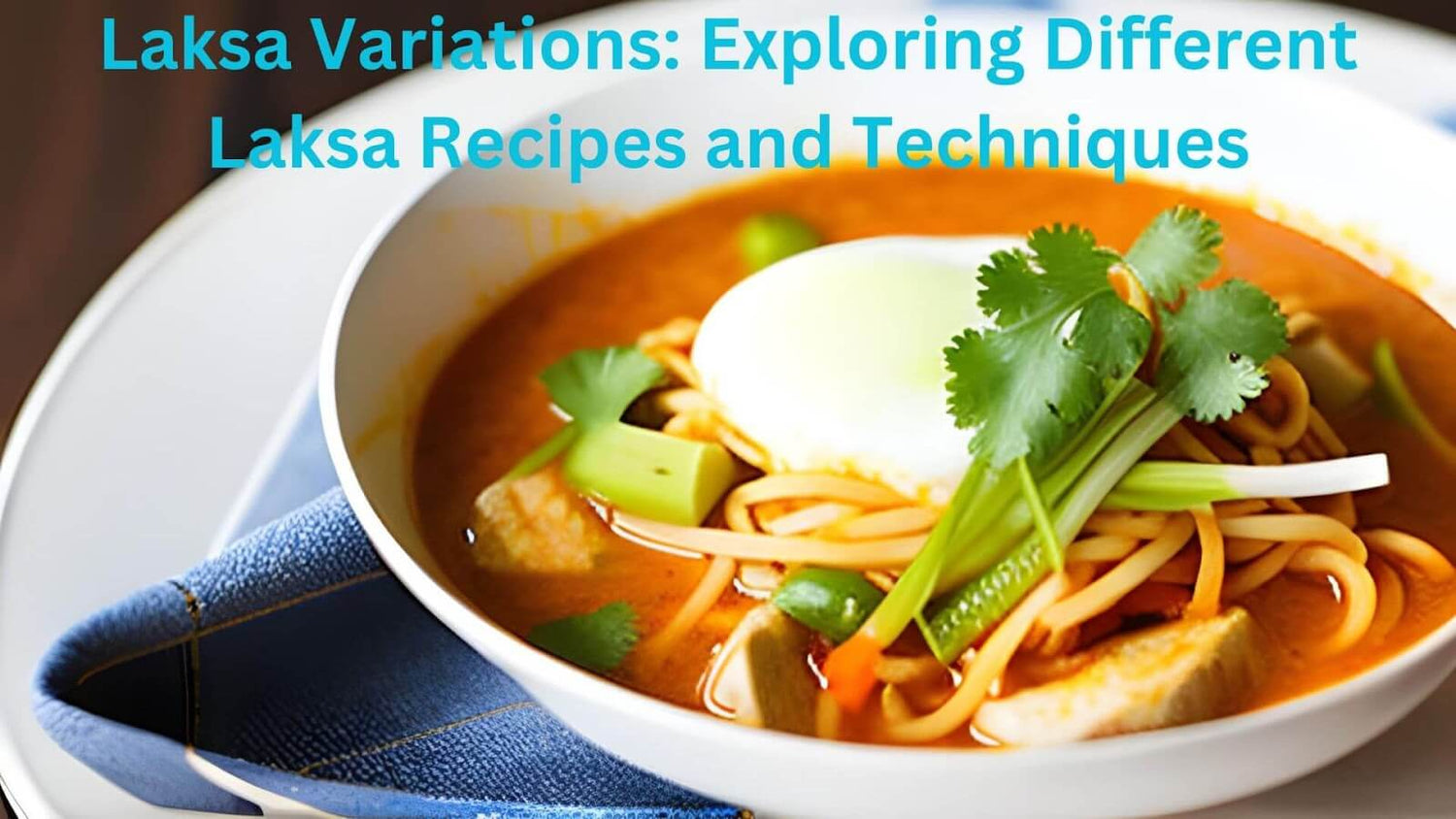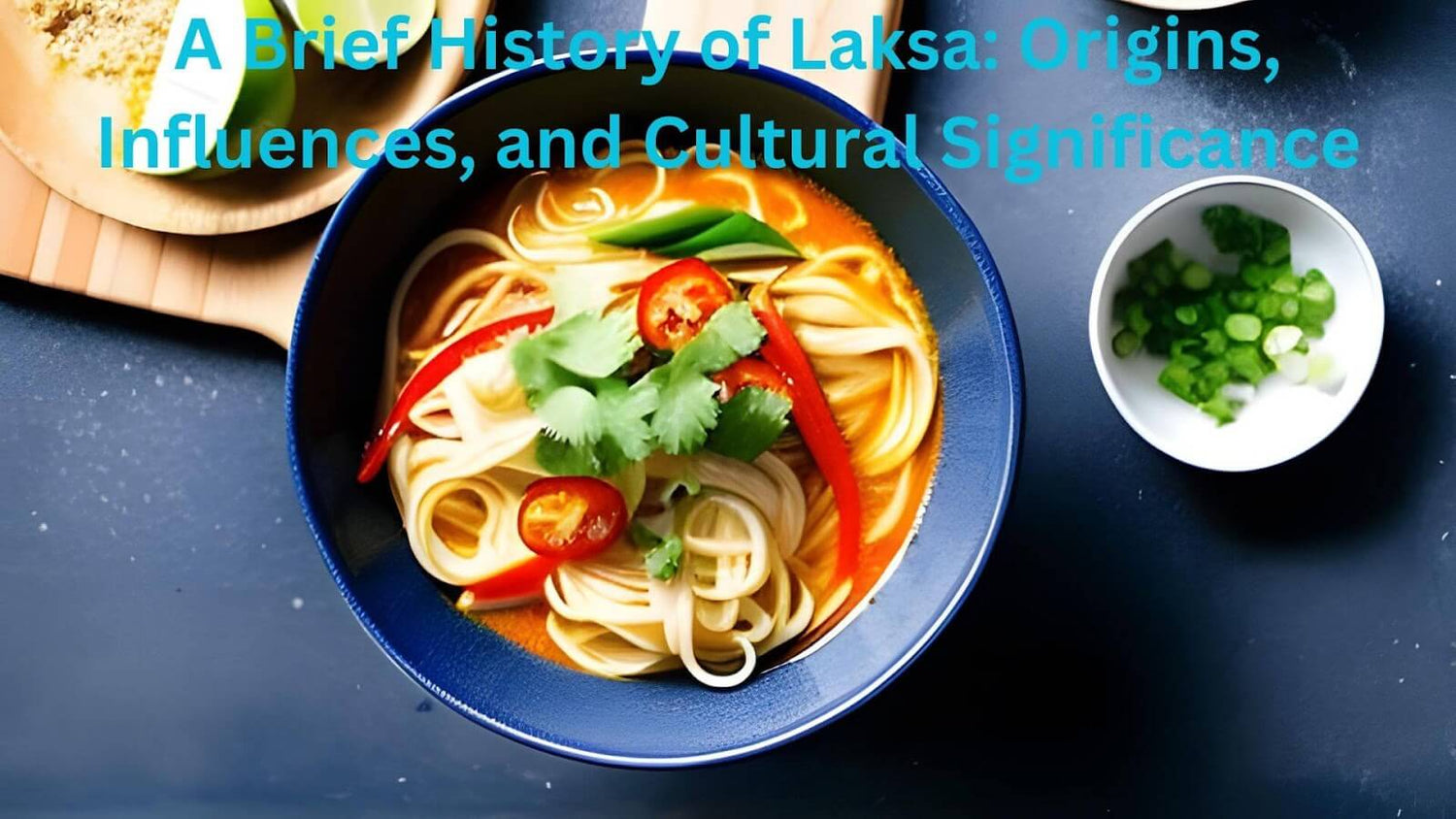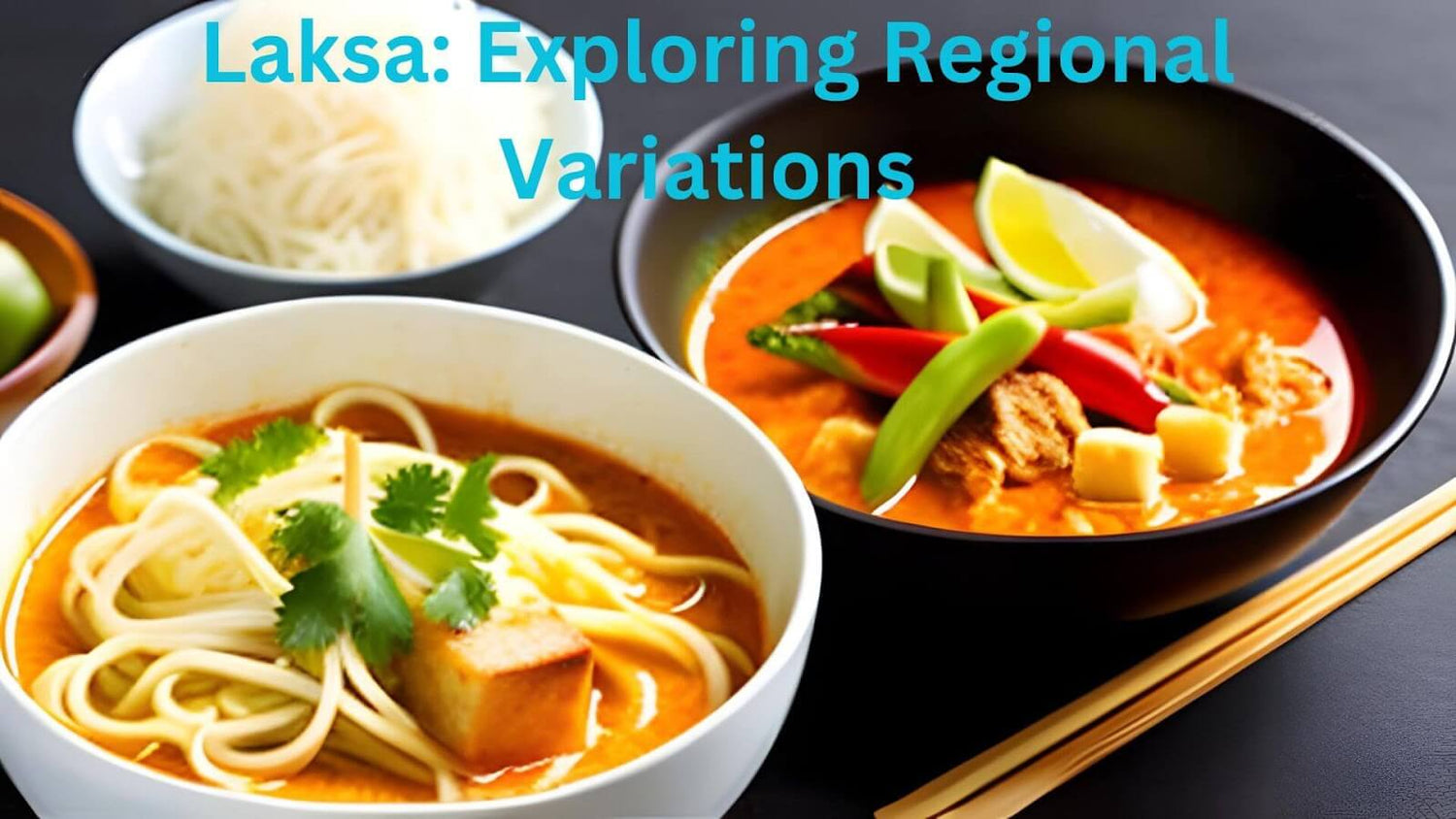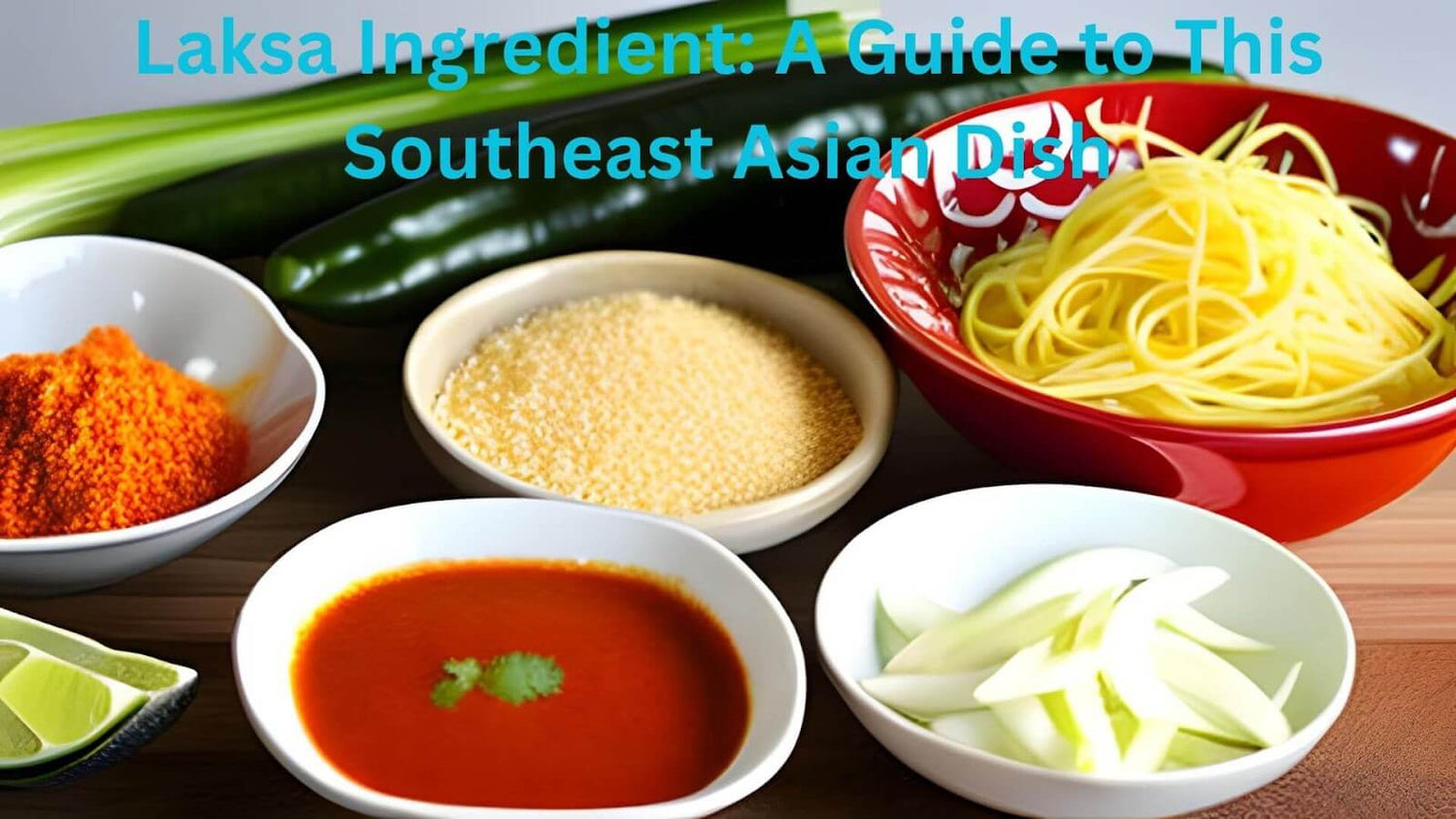Collezione: Laksa
The Origins and Varieties of Laksa: A Guide to This Iconic Southeast Asian Dish
Introduction
Laksa is a popular spicy noodle soup that is commonly found in Southeast Asia, particularly in Malaysia, Singapore, and Indonesia. It is a rich and flavorful food that is loved by many. The soup is typically made with a coconut milk base and infused with a variety of aromatic spices, such as lemongrass, galangal, and turmeric. The food is usually served with rice noodles and a variety of toppings, including shrimp, tofu, vegetables, and herbs.
There are many variations of Laksa across the different regions where it is enjoyed. For example, in Singapore, there are two main types of Laksa: Curry Laksa, which is made with a rich, spicy broth, and Asam Laksa, which has a sour and tangy flavor. In Malaysia, the most popular type of Laksa is known as Laksa Lemak, which is made with a creamy coconut milk base and topped with seafood, chicken, or beef.
No matter the variation, Laksa is a delicious and satisfying food that is sure to warm you up on a chilly day or satisfy your craving for something spicy and flavorful.

What are the Origins and Variations of Laksa?
Origins of Laksa
Laksa's exact origins are debated, but it is generally believed to have originated in Southeast Asia, specifically in the region that includes Malaysia, Singapore, and Indonesia. The food is thought to have evolved over time as a fusion of Chinese and Malay cuisines, as well as Indian and Peranakan influences.
Variations of Laksa
Singapore Laksa:
Singaporean Laksa is a coconut-based curry noodle soup that is rich, creamy, and spicy. It is typically made with a mix of Chinese and Malay ingredients, such as prawn, fish cakes, and bean sprouts. There are two main types of Laksa in Singapore: Curry Laksa, which is the more common one, and is made with a coconut milk and curry base, and Assam Laksa, which has a tangy, sour flavor and uses tamarind instead of coconut milk.
Indonesia Laksa:
Indonesian Laksa is called Laksa Betawi and is a rich, creamy soup made with coconut milk, chicken or beef broth, and a variety of spices, such as coriander, cumin, and turmeric. It is typically served with rice vermicelli noodles, hard-boiled eggs, and fried tofu. Laksa Betawi is unique in that it also includes a range of toppings such as sliced beef or chicken, boiled potatoes, and bean sprouts.
Malaysia Laksa:
Malaysian Laksa, also known as Laksa Lemak, is a creamy, coconut-based soup that is popular throughout the country. It is typically made with a spicy broth, coconut milk, and a variety of herbs and spices, such as lemongrass, ginger, and turmeric. The food can be served with a range of toppings, including shrimp, chicken, tofu, and fish cakes.
There are several regional variations of Laksa in Malaysia, such as Penang Asam Laksa, which uses tamarind and mackerel fish, and Sarawak Laksa, which includes prawns, shredded chicken, and omelet strips.
Overall, Laksa is a flavorful and beloved food throughout Southeast Asia, with each country putting their own unique spin on this delicious noodle soup.
What are the main Ingredients used in Laksa?
Certainly! Laksa is a food with a complex and flavorful broth that typically contains a wide range of ingredients. Here are some of the main ingredients you might find in a typical Laksa:
Coconut milk
One of the signature ingredients in Laksa is coconut milk, which gives the broth its rich, creamy texture and adds a subtle sweetness. Coconut milk is made by blending grated coconut flesh with water and then straining it to create a thick, creamy liquid.
Lemongrass
A fragrant and citrusy herb, lemongrass is a key ingredient in many Southeast Asian dishes, including Laksa. It adds a bright, fresh flavor to the broth and is typically used in its whole form, with the tough outer layers removed and the stalks bruised to release their flavor.
Galangal
A member of the ginger family, galangal is a root that has a pungent and slightly citrusy flavor. It is often used in Laksa to add depth and complexity to the broth, and is typically sliced thinly or grated and added to the soup.
Shrimp paste
Made from fermented shrimp, shrimp paste is a popular ingredient in many Southeast Asian cuisines. In Laksa, it is used to add a savory, umami flavor to the broth. It is typically added in small amounts and combined with other ingredients to create a complex and flavorful base.
Rice noodles
A staple in many Asian cuisines, rice noodles are a type of noodle made from rice flour. They are typically used in Laksa to add texture and to soak up the flavorful broth. Rice noodles come in a variety of shapes and sizes, and are often available in both fresh and dried forms.
These are just a few of the many ingredients that can be used in Laksa, but they give you an idea of some of the key flavors and textures that make this food so delicious!
What is the Flavor Profile of Laksa and Pairings?
Laksa is a food with a complex flavor profile that is both spicy and savory, with a hint of sweetness and a range of aromatic herbs and spices. Here are some of the key elements of Laksa's flavor profile:
- Spicy: Laksa is known for its heat, which comes from a combination of fresh chilli peppers, dried chilli flakes, and spices like ginger and turmeric.
- Savory: The broth in Laksa is typically made with a variety of umami-rich ingredients like prawn paste, fish sauce, and coconut milk, which contribute to its savory flavor.
- Aromatic: Herbs like lemongrass and galangal give Laksa its distinctive aroma, while other spices like coriander and cumin add depth and complexity.
- Sweet: Coconut milk and sometimes palm sugar or other sweeteners are added to the broth to balance out the spice and create a slightly sweet flavor.
As for pairings, Laksa is typically served with a variety of accompaniments that help to balance out the heat and richness of the broth. Here are a few suggestions:
-
Fresh herbs and vegetables: Laksa is often served with a variety of fresh herbs and vegetables, such as bean sprouts, cilantro, and mint. These ingredients add a bright, refreshing flavor and crunch to the food, and can also help to balance out the heat.
-
Fried or crispy toppings: To add some texture and richness to Laksa, you might try topping it with some fried shallots or garlic, crispy tofu or tempeh, or even some fried chicken or shrimp. These toppings can add a savory crunch that pairs well with the spicy and aromatic flavors of the broth.
What makes the Laksa by Nasibakrigourmet special?
Unique blend of spices and herbs
Every Laksa has its own blend of spices and herbs, which can greatly affect the flavor and aroma of the food. Nasibakrigourmet may have their own special blend that sets their Laksa apart.
Use of high-quality ingredients
Laksa can be made with a wide variety of ingredients, but using high-quality ingredients can make a significant difference in the overall taste and texture of the dish. Nasibakrigourmet may use only the freshest and most flavorful ingredients in their Laksa.
A secret family recipe
Many families and restaurants have their own secret recipes for Laksa that have been passed down through generations. Nasibakrigourmet may have their own unique family recipe that has been perfected over time.
Customization options
Some restaurants allow customers to customize their Laksa by choosing their preferred level of spiciness or adding extra ingredients. Nasibakrigourmet may offer unique customization options that allow customers to tailor their Laksa to their specific preferences.
Creative presentation
While Laksa is traditionally served in a bowl, Nasibakrigourmet may have their own creative way of presenting the dish that makes it stand out visually and adds to the overall experience of enjoying their Laksa.
Health Benefits of Laksa
Laksa is a dish that is packed with a variety of healthy ingredients, which can offer several potential health benefits. Here are a few of the health benefits of Laksa:
Rich in nutrients
Laksa typically contains a variety of vegetables, proteins, and spices, which can provide a range of essential vitamins, minerals, and antioxidants. For example, coconut milk used in Laksa is high in healthy fats, vitamin C, iron, and potassium. Vegetables like bean sprouts, carrots, and bell peppers are rich in vitamins and minerals.
May boost immune system
Some of the spices used in Laksa, such as ginger, turmeric, and garlic, have anti-inflammatory and antioxidant properties that may help to boost the immune system and reduce the risk of certain diseases.
May aid digestion
Laksa is a rich source of dietary fiber, which is essential for maintaining healthy digestion. Additionally, the spices used in Laksa, such as lemongrass and turmeric, are known for their digestive properties and may help to reduce bloating and other digestive issues.
May help with weight management
Laksa can be a filling and satisfying meal that provides a range of nutrients without being excessively high in calories. Additionally, the healthy fats in coconut milk and the protein in seafood or tofu can help to keep you feeling full for longer and may help to reduce cravings for unhealthy snacks.
May support cardiovascular health
The healthy fats in coconut milk and seafood used in Laksa, as well as the anti-inflammatory properties of some of the spices, may help to support cardiovascular health by reducing inflammation, improving cholesterol levels, and reducing the risk of heart disease.
Conclusion
In conclusion, Laksa is a delicious and nutritious dish that has its origins in Southeast Asia. It is made with a variety of ingredients such as noodles, spices, vegetables, and seafood, all of which provide numerous health benefits. Some of the potential health benefits of Laksa include boosting the immune system, aiding digestion, and supporting cardiovascular health.
When it comes to the Laksa by Nasibakrigourmet, there are several reasons why it may stand out. They may use a unique blend of spices and herbs, high-quality ingredients, or have their own secret family recipe. Additionally, they may offer customization options or creative presentations that enhance the overall experience of enjoying their Laksa.
If you're looking to try some delicious Laksa, Nasibakrigourmet may be an excellent choice. Their Laksa paste may provide a range of health benefits while also being a flavorful and satisfying meal. So why not give it a try and experience the unique taste and health benefits of Laksa by Nasibakrigourmet!
FAQ
1. What type of noodles are traditionally used in Laksa?
Rice noodles are traditionally used in Laksa. However, some variations of Laksa may use other types of noodles, such as wheat noodles or vermicelli.
2. Is Laksa usually spicy or mild?
Laksa can vary in spiciness depending on the specific recipe and individual preferences. Some versions of Laksa may be mild, while others may be very spicy.
3. Can Laksa be made without coconut milk?
Yes, Laksa can be made without coconut milk. However, coconut milk is a key ingredient that gives Laksa its distinct flavor and creamy texture, so the dish may taste different without it.
4. Are there any vegetarian or vegan options for Laksa?
Yes, there are vegetarian and vegan options for Laksa. Instead of seafood or meat, tofu or vegetables can be used as a protein source. Additionally, vegetable broth or coconut milk can be used as a substitute for chicken or beef broth.
Nessun prodotto trovato
Utilizza meno filtri o rimuovi tutto
Sub Collection
-

Laksa Recipes
Laksa Variations: Exploring Different Laksa Recipes and Techniques for This Classic Southeast...
-

Laksa History
A Brief History of Laksa: Origins, Influences, and Cultural Significance Laksa is a...
-

Laksa Types
Laksa Around the World: Exploring Regional Variations of This Popular Dish Laksa...
-

Laksa Ingredient
Laksa Ingredient: A Guide to This Flavorful Southeast Asian Dish Laksa is...




